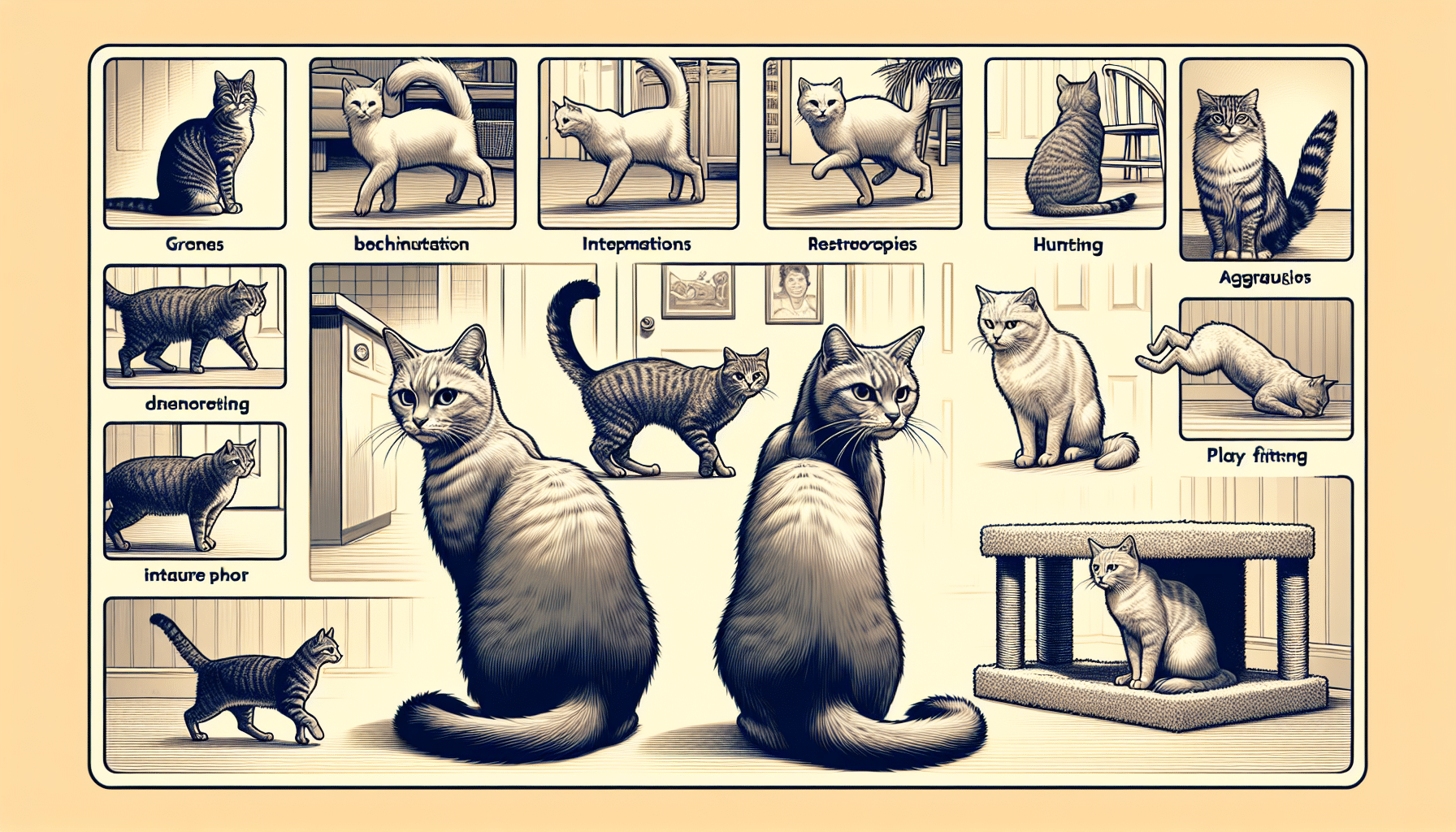Understanding why cats bite each other’s necks can be critical for pet owners living in multi-cat households. This behavior often stems from a combination of play fighting, aggressive tendencies, or social dynamics among feline friends. Recognizing the root causes of this behavior not only helps in understanding cat interactions but also in preventing potential problems. In this guide, we’ll explore the nuances of this behavior, insights into feline communication, and strategies for fostering harmony in multi-cat environments.
Understanding Feline Interactions
To effectively manage and nurture the relationships between your cats, it is essential to understand feline interactions, including body language. Cats communicate extensively through various signals, and being able to interpret these can help prevent negative behaviors, such as cat biting. A significant factor in feline interactions is the concept of social hierarchy and dominance. In a multi-cat household, one cat may assert dominance by biting another’s neck as a display of power. Additionally, territoriality plays a crucial role in these dynamics; a cat may bite another cat’s neck out of fear of competition for resources.
Key Factors in Feline Interactions:
- Social Hierarchy: Establishes a pecking order among cats.
- Territoriality: Cat biting can stem from the need to assert control over space and resources.
- Body Language: Understanding signals can prevent misunderstandings that lead to aggression.
Cat Aggression
Cat aggression can manifest in various forms, one of which is inter-cat aggression, where one cat displays aggression towards another cat. This type is particularly common in multi-cat households where the cats may feel threatened or compete for resources. Potential causes of cat aggression include fear, stress, or guarding resources like food or litter boxes. It is critical to recognize that when a cat bites another cat’s neck, it can be a clear indication of aggression, potentially triggered by specific circumstances or past experiences.
Common Causes of Cat Aggression:
- Resource Guarding: A cat may bite to protect food or territory.
- Stress or Fear: Changes in the environment can lead to heightened aggression.
- Overstimulation: Cats can react aggressively if they become overly excited during play.
Feline Body Language
Understanding feline body language is crucial to interpreting your cats’ emotions and intentions accurately. Cats use a range of signals to communicate their feelings; recognizing these can aid in preventing confrontations. For example, a hissing cat may be warning another to back off, while swatting and growling can indicate irritation that could lead to a bite. By learning how to interpret these signals correctly, cat owners can take proactive measures to diffuse tense situations and promote positive interactions.
Key Body Language Signals of Aggression:
| Signal | Interpretation |
|---|---|
| Hissing | Warning or discomfort |
| Growling | Threatening behavior |
| Swatting | Aimed at deterring another cat |
Learning to respond appropriately to these indicators can make a significant difference. By providing a safe and structured environment for your cats, you can mitigate the risks associated with cat biting and aggression. If issues persist, consider consulting with a veterinarian or a cat behaviorist for tailored advice.
For further insights into maintaining feline harmony, consider resources such as the American Veterinary Medical Association or the ASPCA. You can also explore behavioral guidance through the Fear Free Pets program.

Understanding why cats bite each other’s necks involves delving into the complexities of feline behavior. Biting can often be a display of cat aggression, signaling various underlying emotions such as dominance or playfulness. In a multi-cat household, these interactions can be particularly pronounced, making it vital for pet owners to recognize the signs and understand their cats’ social hierarchy. Let’s take a closer look at cat dominance behavior, multi-cat dynamics, and how these factors contribute to neck-biting.
Cat Dominance Behavior
Cat dominance behavior can manifest in various ways, including biting other cats’ necks as a show of status or control. Dominance is often related to territorial instincts and can escalate during interactions over resources such as food and litter boxes. Cats establish hierarchy within a group, and sometimes an assertive cat may assert its position by gently biting its peers, particularly on the neck. Understanding this behavior requires observing feline body language and being aware of the social structure within your home.
- Recognize the signs of dominance, such as posture and vocalization.
- Monitor interactions to identify any patterns of aggressive behavior.
- Provide separate resources (litter boxes, food bowls) to reduce competition.
Establishing a clear hierarchy can help mitigate dominance-related issues. Some strategies include providing ample resources for each cat and fostering positive interactions through playtime and mental stimulation. Respected resources like the American Veterinary Medical Association (AVMA) recommend recognizing these dynamics early to ensure a peaceful household.
Multi-Cat Household Dynamics
Introducing new cats into an existing group can instigate aggressive behaviors, including neck biting. Cats are territorial creatures, and the dynamics of a multi-cat household can be complex. Conflicts may arise if the new cat challenges the established hierarchy, leading to stress and potential for fights. Understanding feline interactions is crucial for pet owners to create a harmonious environment.
- Gradually introduce new cats to existing ones to minimize stress.
- Use scent swapping techniques to familiarize cats with one another.
- Establish safe spaces for each cat to retreat when feeling overwhelmed.
To maintain peace in a multi-cat home, ensure that there are sufficient resources and comfortable places for each cat. Building positive associations and carefully observing interactions can help in preventing aggressive behaviors. For more insights on feline dynamics, consider visiting resources like PetMD or CDC – Healthy Pets.
Cat Play Fighting
It’s essential to differentiate between play fighting and actual aggression in cats. Play fighting often includes behaviors like biting each other’s necks, which helps them develop social skills and improve their muscle strength. During play, cats may alternate roles of ‘predator’ and ‘prey,’ and biting can be part of their normal interaction. Observing their body language will help you determine whether their behavior is playful or hostile.
- Look for signs of relaxed body posture and occasional vocalizations during play.
- Watch for hissing or growling, which may indicate real aggression.
- Provide toys to redirect energy and encourage positive interaction.
By understanding the nuances of play fighting, cat owners can foster healthier relationships among their pets. For more detailed information, check out Vetstreet for insights on managing feline play behaviors.
Preventing Cat Fights
Preventing cat fights is crucial in maintaining a peaceful environment for your pets. Practical measures include ensuring sufficient resources (food, water, litter boxes) are available and creating a safe, stress-free area for each cat. Constant monitoring can help spot any signs of impending aggression, allowing for timely interventions. Keeping their environment enriched with toys and stimulating activities can also reduce aggression.
- Redirect aggressive behavior using toys instead of physical confrontation.
- Practice positive reinforcement training to promote good behavior.
- Consult a veterinarian or animal behaviorist if fights persist.
| Resource | Recommendation |
|---|---|
| Food bowls | One per cat, plus one extra |
| Litter boxes | One per cat, plus one extra |
| Scratching posts | At least one per cat |
For more tips on fostering a peaceful multi-cat household, visit VCA Animal Hospitals to access their resources on cat behavior and conflict resolution. By understanding the complexities of cat interactions, you can ensure a safer and more peaceful home for your beloved companions.

Cats may engage in behaviors that seem aggressive to their owners, such as biting each other’s necks. This behavior can be part of play or dominance displays, but it can also stems from underlying cat aggression issues. Understanding feline body language and their interactions is crucial, especially in a multi-cat household where dynamics can shift frequently. If cat biting other cats’ necks becomes a recurrent problem, seeking professional help from a veterinarian or animal behaviorist is essential to prevent aggression from escalating and to maintain harmony in your home.
Cat Behavioral Issues
Unresolved cat aggression, such as biting each other’s necks, can lead to a myriad of behavioral issues, making it vital for pet owners to recognize and address these problems promptly. When cat aggression is left unchecked, it may manifest as destructive behavior like clawing furniture or even litter box problems, where a cat refuses to use its litter box out of stress or territorial disputes.
Cat owners must be vigilant about these signs of aggression and seek professional help if necessary. The consequences of not addressing cat behavioral issues can be significant, including:
– **Increased stress** for the cats involved
– **Health problems** related to prolonged aggression or anxiety
– **Potential harm** to other animals or family members
Actively addressing cat aggression ensures a peaceful and healthy environment for all pets in the household. For more detailed insights on feline behavior, consider exploring resources from the [American Veterinary Medical Association (AVMA)](https://www.avma.org/).
Preventing Cat Fights
To manage and reduce aggression, it is essential to implement strategies that promote positive feline interactions. Understanding feline interactions can sometimes help prevent escalation. Here are some effective approaches:
– **Create vertical spaces:** Cats feel safer and less threatened when they have places to climb and observe the household from above.
– **Monitor playtime:** Distinguish between cat play fighting and aggression to intervene effectively if fights escalate.
– **Use pheromone diffusers:** These can help reduce tension between cats by providing a calming effect in their environment.
This proactive approach fosters a more peaceful coexistence in multi-cat households, making vigilance and intervention key components of pet leadership.
Conclusion
In summary, understanding why cats bite each other’s necks can shed light on broader issues of cat aggression and feline body language. Acknowledging these behaviors and their implications can significantly enhance the well-being of your pets. Social dynamics in a multi-cat household require careful observation and, when necessary, intervention from a professional to ensure a harmonious living environment.
As a trusted resource, Vet Today is here to support pet owners facing these challenges. Our team can guide you in understanding your cat’s behavioral issues, helping to keep your furry friends safe and healthy. Seeking assistance can pave the way for a contented and well-adjusted feline family.
FAQs
What causes cats to bite each other’s necks?
Cats may bite each other’s necks during play fighting, as a form of dominance behavior, or due to unresolved aggression in multi-cat household dynamics.
How can I tell if my cats’ play fighting is becoming too aggressive?
Signs of aggressive play fighting can include hissing, growling, or one cat displaying submissive behaviors while the other persists. If one cat is unwilling to engage, it may be time to separate them.
What should I do if my cats are fighting?
To intervene, distract the fighting cats using loud noises or throwing a toy. Avoid physically getting between them as you may get injured. Seek professional help if fighting escalates.
Can I train my cats to stop aggressive behavior?
Yes, training is possible with positive reinforcement techniques and understanding the triggers behind their aggressive behavior. Consult a professional for tailored strategies.
How can I prevent aggression in a multi-cat household?
Implementing environmental enrichment, providing separate resources, and monitoring interactions can reduce competition and aggression among cats.
For further resources on managing cat behavior, visit [PetMD](https://www.petmd.com/) or the [ASPCA](https://www.aspca.org/).





